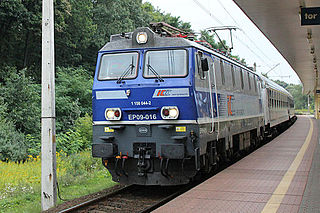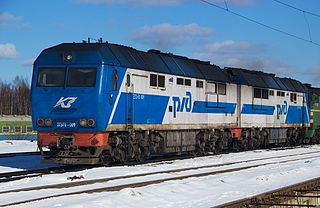
Multiple-unit train control, sometimes abbreviated to multiple-unit or MU, is a method of simultaneously controlling all the traction equipment in a train from a single location—whether it is a multiple unit comprising a number of self-powered passenger cars or a set of locomotives—with only a control signal transmitted to each unit. This contrasts with arrangements where electric motors in different units are connected directly to the power supply switched by a single control mechanism, thus requiring the full traction power to be transmitted through the train.
Brush Traction was a manufacturer and maintainer of railway locomotives in Loughborough, England whose operations have now been merged into the Wabtec company's Doncaster UK operations.

An electro-diesel locomotive is a type of locomotive that can be powered either from an electricity supply or by using the onboard diesel engine. For the most part, these locomotives are built to serve regional, niche markets with a very specific purpose.

The M62 is a Soviet-built diesel locomotive for heavy freight trains, exported to many Eastern Bloc countries as well as to Cuba, North Korea and Mongolia. Beside the single locomotive M62 also twin versions 2M62 and three-section versions 3M62 have been built. A total number of 7,164 single sections have been produced, which have been used to build 5,231 single-, twin- and three-section locomotives.

EP09 is a Polish electric locomotive used by the Polish railways, Polskie Koleje Państwowe (PKP) and produced by Pafawag of Wrocław between 1986 and 1997.

The Soviet locomotive class IS was a Soviet passenger steam locomotive type named after Joseph Stalin. The contract design was prepared in 1929 at V.V. Kuybyshev Locomotive Factory in Kolomna, Russian SFSR. The IS series locomotives were manufactured between 1932 and 1942. The last one was built in 1942 during the Great Patriotic War against Nazi Germany.

TU2 (ТУ2) is a Soviet narrow gauge diesel locomotive for the track gauge of 750 mm

Class E 499.1 electric locomotives were constructed and built by Škoda Works in Plzeň for use in Czechoslovakia by the ČSD. They were also used outside Czechoslovakia in Poland as class EP05 and in the Soviet Union as ЧС3 (ChS3). In North Korea, licence built copies were used.

The DRB Class 42 was a type of steam locomotive produced for the Deutsche Reichsbahn. It is one of the three main classes of the so-called war locomotives (Kriegslokomotiven), the other two being class 50 and 52.

Electric locomotive EP1 is a Russian electric locomotive which has been produced by Novocherkassk Electric Locomotive Plant since 1998. It is the first Russian passenger electric locomotive with the 2o-2o-2o or Bo-Bo-Bo axle arrangement. There are, as December 2016, 866 of these locomotives.

TE10 is a diesel-electric locomotive from the Soviet Union. The name of this locomotive (ТЭ10) is from тепловоз с электрической передачей, тип 10, which translates to "diesel-electric locomotive type 10."

The ChS4 is an electric mainline AC passenger locomotive used in Russia, Belarus, and Ukraine.

The ChS8 is an electric mainline AC passenger locomotive used in Russia and Ukraine.

The ChS7 is an electric mainline DC passenger locomotive used in Russia and Ukraine. The locomotive consists of two sections and was produced in years 1983 to 1999 at Škoda's V.I. Lenin plant in Plzeň, Czech Republic. It was specially developed for the railways of Soviet Union with later models procured by Russian and Ukrainian operators. Along with ChS8, the Chs7 is one of the most powerful electric locomotives used in the countries of the former USSR.

The ChS2 Russian: ЧС2 is an electric mainline DC passenger locomotive used in Russia and Ukraine. It was manufactured by the Škoda Works in Czechoslovakia between 1958 and 1973.

The VL11 Russian: ВЛ11 is an electric mainline DC freight and passenger locomotive, built in Georgia, used in Russia and Ukraine. The initials VL are those of Vladimir Lenin, after whom the class is named.

The TEP70 is a main line single-unit diesel locomotive, rated at 2,964 kW (3,975 hp), with AC/DC transmission and individual axle traction control, designed to haul passenger trains on the Russian gauge railway network of eastern Europe. As of 2022, it is still in service in Russia, Ukraine, Belarus, Estonia, Latvia, Lithuania, and Kazakhstan. It is the successor to the TEP60, with many design elements is derived from that locomotive; however, the engine was replaced by a four-stroke one. TEP70, especially its experimental batch, incorporated some features of British Rail HS4000, for example, its bogies and some elements of driving control equipment. Later batches of this locomotive incorporated some design features from TEP75 experimental locomotive and predecessor TEP70. Final batches, produced until 2006, also had several important improvements.

The 2TE70 is a Russian main line dual unit freight diesel locomotive, rated at 5,884 kW (7,891 hp). It has AC/DC transmission and individual axle traction control and is designed to haul freight trains on the Russian Federation lines RŽD with 1,520 mmRussian gauge. The 2ТE70 Freight diesel locomotive with two six-axle sections shares main parts with the TEP70 and TEP70BS passenger diesel locomotives. Each section is rated at 2,964 kW (3,975 hp) and it is designed for running freight trains of up to 6,000 t.

The EP200 passenger AC electric locomotive has 8,000 kilowatts (10,730 hp) of power and design speed of up to 200 kilometres per hour (120 mph). The underframe with two unique four-axle wheel trucks coupled with support - frame suspension of commutator-less motors and traction gear boxes ensure high riding properties and dynamic characteristics of the EP200 Passenger Electric Locomotive.

The 2TE25K is a main line two-unit diesel-electric locomotive, rated at 5,000 kW (6,705 hp). It is equipped with AC/DC transmission and is designed to haul freight trains on the Russian Federation lines RZD on the broad gauge.
























